 |
 |
 |
|
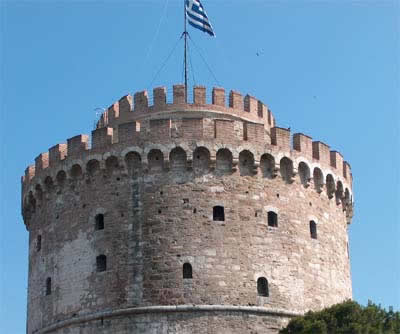 |
The White Tower in Thessaloniki served as a very visible
guidepost when the 34 members of the USITT Study Tour visited that city.
The tour of Greece began in Macedonia. Photos/Richard Durst 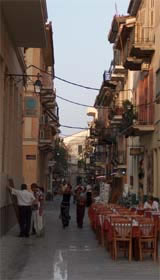
The narrow streets of Nafplio were both intriguing and challenging
for members of USITT's study tour.
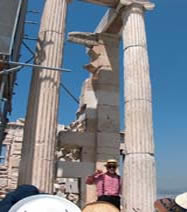
One of of the chief curators of the Acropolis, Dr. Tanoulas,
led the USITT Study Tour on a rare, behind the scenes tour of the site.

Climbing the 999 steps to the fortress ruins
above Nafplio was a test of
travel-strengthened legs.
|
|
|
Wonderful, Unusual
Sights of Greece In early July, 34 participants of the USITT Study Tour to Greece returned to the United States exhausted, stimulated, and enthusiastically ready for the next adventure. They spent two weeks visiting ancient theatres, climbing the ruins of the Greek heritage, becoming "experts" on the native cuisine (how much calamari can a single person eat in 15 days?), and experiencing the cultural differences between the countries. Based on suggestions from previous tours, in each major area participants used a single city as a base from which to explore rather than move from hotel to hotel, night after night. Another tour group was booked into 18 hotels in 21 days, and we were thankful this was not our schedule! It enabled us to unpack and have a place to return to that was familiar. Most importantly, not having to pack and move every morning allowed us to be the first group at heritage sites; to have the places to ourselves was very special. The group began its tour in Macedonia, based in Greece's second largest city, Thessaloniki. There was free time to explore after a half-day city tour, and it proved to be much like Rome. Every block and every corner unveiled a new vista, whether the series of spectacular Byzantine churches, the excavations of the Roman Forum, or the old walled Upper City. Each brought new experiences. Several were moved by the serenity of the Byzantine church high above the city with its walls blackened by centuries of smoke from the candles - the site where Paul first addressed the citizens of Salonica (Thessaloniki). The interior is so small that the 30 in the group left no room for others. The center of Thessaloniki was so easy to navigate, radiating out from Aristotle Square with the White Tower often visible along the shoreline. Lovely sidewalk cafés, opposite excavation sites, ruins, or Byzantine churches, plus the thrill of eating along the harbor or in the old market produced memories that will last forever. As is typical of USITT tours, there were unusual, off-the-beaten-path areas to explore, as well as visits to the important sites across the country. Among the former was a morning visit to the American Farm School, founded in 1904, initially to provide agricultural training to orphans from Greece and the Balkans. Missionary John Henry House provided the guiding principles that still drive AFS today. It was an interesting departure from the theatre-oriented itinerary. They provided a great lunch - food from the Farm School. A day trip to Veria and Vergina completed the northern swing. Veria is a small village in the foothills an hour outside Salonica - quaint, with twisted cobbled streets, beautiful flowers, and sidewalk fruit and vegetable stands common throughout the smaller towns. The old Jewish quarter and small synagogue were reminders of the strong Jewish population that lived there before being decimated by the Nazis. Vergina's underground museum was one of the finest visited, housing tombs in situ and relics from the excavations. Four members hiked in the mid-day heat to the small theatre still being excavated about a mile from the main site overlooking the valley. It was here that Phillip II was killed as he entered the theatre (we all know how dangerous theatres are…), with strong beliefs by some historians that his son, Alexander the Great, masterminded the assassination. While the signs in the big cities were dual language, group members were pleased to have a driver in the countryside, finding the way while allowing participants to focus on the incredible scenery. 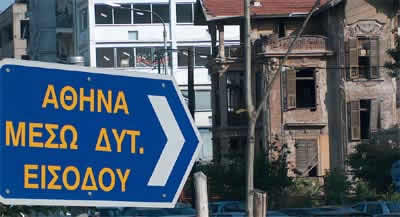
The next stop was Delphi, consulting the Oracle about when there would be relief from the 100˚+ temperatures! All appreciated the magic and mysticism associated with this mountainous site on Parnassus, some of the most beautiful scenery in the country. As promised, the group was the very first on the site in the morning, and members got to explore the ruins, the theatre, and the stadium high in the mountains without the hoards of tourists on day-trips from Athens that always arrive midday. This was truly a highlight of the tour. The museum at the ruins was a scenery designer's delight with marvelous architectural details and the ability to really appreciate the scale of the buildings and décor. The town of Delphi is two streets, and participants had a great time exploring the village and even finding a couple of hours at the swimming pool one afternoon - luxurious! For the next four days, the group used Nafplion on the Greek Peloponnese as home base. Karen and Dick Durst had vacationed here in the late 1980s when it was the perfect Mediterranean fishing village, and they were anxious to return. In the intervening 17 years, Nafplio has become a great vacation spot for the Greeks and has become a modern seaport, yet the narrow side streets, town squares and parks still provided a wonderful, peaceful home base. Group members ate at lovely open-air restaurants, swam in the Ionian salt water and became experts on Mythos beer and Nemean wines, after long days exploring the surrounding countryside and Greek antiquities. We've all heard these names from our theatre history courses and Greek drama, but there's nothing like being there. Epidavros, Mycenae, the House of Atreus, tombs of Clytemnestra and Aegistus - what great experiences! In the evening, participants saw Oedipus Rex sitting on the marble seats at Epidavros. This was after a mid-day session in a costume exhibition hosted by Ioanna Manoledaki, one of the most well-known costume designers in Greece, who led us through the exhibition. The next day the group was again first on the site at the tomb of the House of Atreus, believed to be Agamemnon's resting place. Then they went on to the new excavation at Nemea, where the temple columns lay like dominoes; you can almost feel the earthquake as the segments lay in perfect formation after 2000 years. It was a marvelous Fourth of July with several members of the group climbing the 999 steps to the fortress ruins above Nafplio to see the entire valley city and bay laid out below. Their collective calves and thighs paid a price for the adventure, but none would give up the breathtaking experience. After a day of enjoying the village, the ocean, the Folk Museum, and costume collection and after shopping for special gifts, the group returned to the hotel for a grand Independence Day celebration on the rooftop garden of the hotel. The staff found an American flag and one of the waiters led the group in a Greek folk dance. Most will remember the celebration so far from home. The last three days in Athens were a blur with so many sites, island visits, Helena's temple, Poseidon's ruins and, most spectacularly, a behind-the-barricades visit on the Acropolis with one of the chief curators, Dr. Tanoulas. One of the guides has done Greece tours for 21 years and said she'd never had a group allowed "backstage." Dr. Tanoulas took us step by step through the restoration process, into the marble workshops, into the database inventory, then finally into the center of the Parthenon, itself. The scale can only be appreciated when you are standing next to an Ionic capital that is taller than you are! Numb at the conclusion of four hours of climbing the ruins in 100˚+ temperatures, all would say it was the experience of a lifetime. All regional and national theatres suspend their seasons in the summer and tour productions to various ancient theatre festivals like Epidavros. This meant participants couldn't tour the more contemporary houses. Instead, this became a focus on the ancient sites. The view, for example, of the only extant skene in existence, at the Theatre of Dionysus in Athens, was an interesting juxtaposition of ancient and modern, as it was outfitted for a contemporary music concert the evening of the group's visit. Moving lights, light bridges, and follow boards framed against the skene was fascinating. These Study Tours are so important to expand appreciation and understanding of the world and the cultural differences between our work and that of colleagues in other countries. We were certainly tourists, but with a theatre flair and a designer's curiosity. The group was small enough to remain mobile allowing visits to special sites and almost exclusively to themselves - an experience not to be replicated. Upcoming USITT Study Tours include Southeast Asia (Thailand, Cambodia, and Vietnam) next December/January, and the Prague Quadrennial tour in mid-June of 2007. Watch for more details or visit the USITT web site. 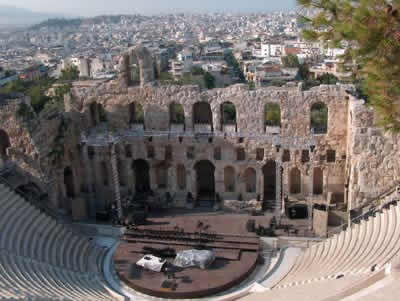
The skene at the Theatre of Dionysus in Athens contrasts with the modern moving light, light bridge, and follow boards installed for a contemporary music concert.
|
||